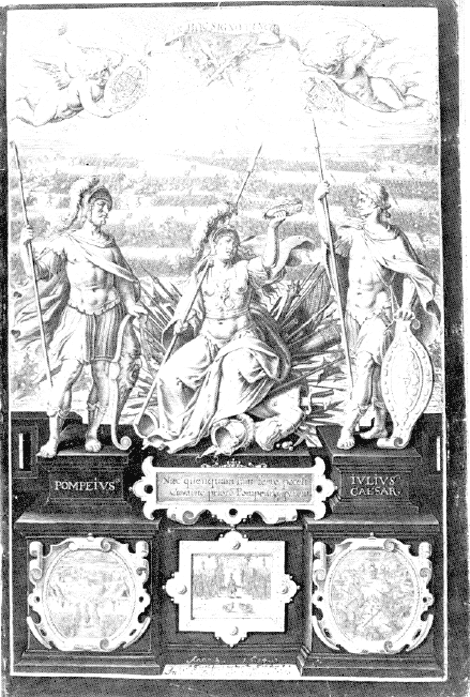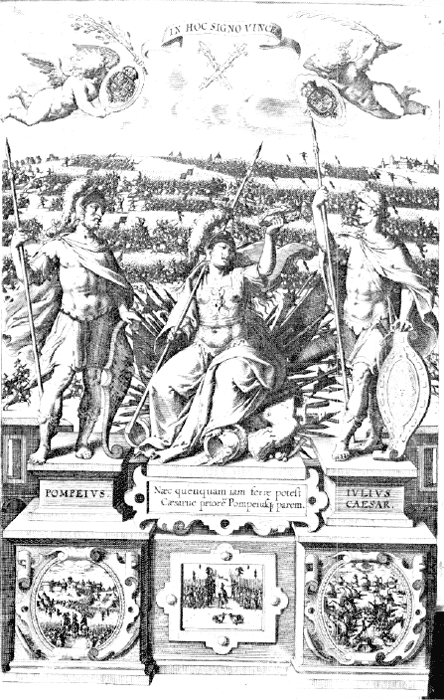De Gulden Passer. Jaargang 57
(1979)– [tijdschrift] Gulden Passer, De–
[pagina 164]
| |
The frontispiece to Imago militiae auspiciis ambrosii spinolae belgicarum copiarum ductoris stataria acie adumbrata. 1614.
| |
[pagina 165]
| |
of the Netherlands, Albert, Archduke of Austria, General Spinola, the commander-in-chief, Louis de Velasquo and Count Bucquoi, his generals, were each carved in effigy, the armies and generals who would one day serve the Infante. With the introduction of artillery and hand-guns the character of war changed fundamentally; manoeuvre became all important in the conduct of battles and war was transformed into an art or science. The great battalions had to be broken up into smaller and manoeuvrable units and in Machiavelli's Art of Warre, 1521, there are six diagrams showing the different formations which were practicable and a double spread demonstrating the best arrangement for a camp including the siting of the market-place and the tents so that all might be defended by the artillery on the perimeter. As well as manoeuvre a complicated drill had to be acquired by the members of all forces; the arquebussiers had to work within the framework of the pikemen and in the cavalry the pistoleers had to be given time after discharging their shot, to retire and re-arm. Models as well as diagrams were helpful for the comprehension of these matters. Henry Prince of Wales was twelve years older than Prince Philip. He too had a model army. There survives in an Account of the Life of Henry Prince of Wales, a description of his war games: ‘having now and then Battles of Head-men appointed both on Horse and Foot, in a long Table; whereby he might, in a Manner, view the right ordering of a Battle, [battle-order] how every Troop did aid and assist another, as also the planing of the Light Horsemen, Vauntguard, main Battle, with the assisting Wings, and Reerwards, etc...’Ga naar voetnoot1 There are specified, in another source, ‘15 pieces of brass ordinance, each one about 22 ynches long... a modell of an Ingin against horses, 2 modells of parapitts. with carrages. for secureing a breach, one modell of a saddell-Tree.’ and again, 17 boards of foot companies.’Ga naar voetnoot2 We may assume that Prince Philip was to work and play with his model army in much the same way. | |
[pagina 166]
| |
The frontispiece shows in the foreground a heavy plinth which stands between two walls pierced by framed slits, below which runs blind arcading. On the central platform of the plinth is a large trophy made up of flags, halberds, two cannon, a mace, pikes, lances and a suit of armour with a sword decorated with a bird-headed handle pushed into the neck. Seated in the centre of the stacked weapons is the figure of a woman with one foot resting on a crested helmet. Most probably she represents Roma. She is portrayed as a warrior and is clad in plumed helmet and chain corselet which has at the neck an ornament in the shape of a male grotesque had; she wears a voluminous skirt and has a cloak over her shoulder; in her right hand is a spear, in her other a laurel wreath which she is handing to Caesar, standing on a base, right; Ceasar wears a cuirass with sleeves and tunic and a wreath on his short cut hair to show that he had won other battles. He carries a spear, wears a sword with a bird-shaped handle and holds a shield decorated to simulate the engraving of a grotesque. The base is inscribe IULIUS CAESAR. Opposite him also on a base, is Pompey, similarly clad, though his cuirass has attached lappets. He has a beard and moustache; on his head a plumed helmt, in his right hand a spear and supported by his left, a shield with a moulded grotesque head on the face. On the base the inscription POMPEIUS. On a curved cartouche beneath the central figure is the inscription, Naec quemquam iam ferre potest Behind the plinth and the walls stretches a rolling plain on which two armies confront each other in battle. Both sides are formed into rectangular columns of infantry and cavalry and all are armed with swords and lances. Flags wave aloft on both sides while among the forces behind Caesar standards with the Roman eagle are seen. On the right is a small walled town containing a circular tower and two mansions with high pitched roofs. On the face of the plinth are placed three cartouches framing scenes; on the left an army is marching into a walled town. Standards with the Roman eagle are carried and it files between open tents. Three mounted trumpeteers accompany the cavalry. The scene in the centre shows a turbaned figure standing between | |
[pagina 167]
| |
two blocks of footmen. He is watching a cock fight. The standards with the Roman eagle rise on both sides. In the background is a mountainous profile and part of a city wall. On the right is a naval battle between galleases. They face each other ram to ram and the men of the ships in the middle of the scene are fighting each other with boarding poles. In the background are galleons in full sail wearing flags and pennants. In the sky on a clear stretch surrounded by cloud, the Ragged Cross of Burgundy which had been a Spanish emblem from the accession of Charles V in 1516 and was peculiarly associated with the Low Countries, the southern regions of which had formed part of mediaeval Burgundy. Inscribed on a scroll above the cross, the motto of Constantine the Great, In hoc signo vinces. Flanking the scroll, two winged cherubs carrying shields each showing the arms of the royal house of Spain, surmounted by the crown and surrounded by the chain of the Order of the Golden Fleece. The cherub on the left holds a laurel branch, and on the right a palm. The object of this frontispiece is to enforce one of the precepts of the sixteenth and seventeenth centuries, that the lessons of antiquity must be learnt if the army was to be given morale and trained in discipline and if contemporary compaigns were to be waged effectively. Struzzius has made the obvious choice of Caesar as his exemplar. Lipsius' famous work, de militia romana... appeared in 1595. The Commentaries, of which a fine edition had been published in Antwerp in 1606, were the best known and most often consulted of all classical military literature. Francis de Vere called Caesar ‘a breviary of soldiers’. The presence of Pompey and the triumphant Caesar, the lines from Lucan's Pharsalia, ‘For Pompey will no equal haue, show that the great battle on the plain is that of Pharsalia. But the distinguishing incidents of that battle have been omitted. In the armour of Caesar and Pompey and the Roman weapongs in the trophy Roman models have been sought out; the motif of the bird-handled sword might have been adopted from the title-page | |
[pagina 168]
| |
to Book 11 of Hubert Goltzius' famous work on Roman medals of 1574Ga naar voetnoot4. No attempt has been made at a thorough reconstruction of the armies of Rome; although Struzzius and his engraver wish to represent another, former time, their historical imagination only takes them to a period just before their own. Missiles propelled by gunpowder are absent, and the pike, but the weapons they use, the lance and the sword, are mediaeval rather than Roman, the walled town on the right with round bastions at the angles is also mediaeval, corresponding roughly to representations of Low Country towns in Münster's Cosmographia, 1550. The town in the little representation at the bottom, left, is likewise late mediaeval; though the manner in which the Roman army winds its way in recalls the advice of Machiavelli, ‘to fortifie thentrance of the tonne, and to keuer the gates of the same with turnyings after such sort, that men cannot goe in nor oute of the gate by right line:’. On the other hand the ships in the sea battle represented on the right are wholly contemporary; galleases such as these, and galleons may be seen in the illustrations to Crescentio's Nautica mediteranea, 1607.Ga naar voetnoot5 In the central cartouche Xerxes, according to the text is shown watching a cockfight. The turban indicates his eastern origin. Struzzius suggests that this event is a parallel to King Philip watching the manoeuvres of his son's model army. But he has made a mistake - it was Themistocles and not Xerxes who is said to have watched a cockfight before the battle of Salamis.Ga naar voetnoot6 In the fine illuminated copy of this frontispiece in the Royal Library, Brussels a contemporary hand has inscribed the legend, Anno 1614 Stephanus Schoore Inu et Sculpsit & Enlumini. If this is true it is Schoore's only known engraving. He worked in the early seventeenth century and was responsible for a cut brass of Jean of Brabant on the monument to him erected in the Church | |
[pagina *1]
| |
 Engraved and ilhimined Frontispiece to Imago Militiae... 1614 by Albertus Struzzius. Royal Library, Brussels.
| |
[pagina *2]
| |
 Engraved Frontispiece to Imago Militiae... 1614 by Albertus Struzzius. British Library. London.
| |
[pagina 169]
| |
of the Recollets in Brussels by the Archduke Albert, which was destroyed in 1695. The motto of Constantine in pride of place suggests the religious rather than territorial aims of Duke Albert and Spinola and foreshadows the characters of the wars soon to break out again. |
|

